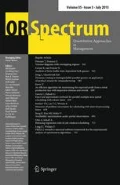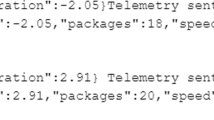Abstract
Certain regulated industries are monitored by inspections that ensure adherence (compliance) to regulations. These inspections can often be with very short notice and can focus on particular aspects of the business. Failing such inspections can bring great losses to a company; thus, evaluating the risks of failure against various inspection strategies can help it ensure a robust operation. In this paper, we investigate a game-theoretic setup of a production planning problem under uncertainty in which a company is exposed to the risk of failing authoritative inspections due to non-compliance with enforced regulations. In the proposed decision model, the inspection agency is considered an adversary to the company whose production sites are subject to inspections. The outcome of an inspection is uncertain and is modeled as a Bernoulli-distributed random variable whose parameter is the mean of non-compliance probabilities of products produced at the inspected site and, therefore, is a function of production decisions. If a site fails an inspection, then all its products are deemed adulterated and cannot be used, jeopardizing the reliability of the company in satisfying customers’ demand. In the proposed framework, we address two sources of uncertainty facing the company. First, through the adversarial setting, we address the uncertainty arising from the inspection process as the company does not know a priori which sites the agency will choose to inspect. Second, we address data uncertainty via robust optimization. We model products’ non-compliance probabilities as uncertain parameters belonging to polyhedral uncertainty sets and maximize the worst-case expected profit over these sets. We derive tractable and compact formulations in the form of a mixed integer program that can be solved efficiently via readily available standard software. Furthermore, we give theoretical insights into the structure of optimal solutions and worst-case uncertainties. The proposed approach offers the flexibility of matching solutions to the level of conservatism of the decision maker via two intuitive parameters: the anticipated number of sites to be inspected, and the number of products at each site that are anticipated to be at their worst-case non-compliance level. Varying these parameters when solving for the optimal products allocation provides different risk-return tradeoffs and thus selecting them is an essential part of decision makers’ strategy. We believe that the robust approach holds much potential in enhancing reliability in production planning and other similar frameworks in which the probability of random events depends on decision variables and in which the uncertainty of parameters is prevalent and difficult to handle.







Similar content being viewed by others
References
Abrams C, von Kanel J, Muller S, Pfitzmann B, Ruschka-Taylor S (2007) Optimized enterprise risk management. IBM Syst J 46(2):219–234
Bamberger KA (2010) Technologies of compliance: risk and regulation in a digital age. Tex Law Rev 88:670–739
Bental A, Nemirovski A (1999) Robust solutions of uncertain linear programs. Oper Res Lett 25:1–13
Bental A, Nemirovski A (2000) Robust solutions of linear programming problems contaminated with uncertain data. Math Program 88:411–424
Bental A, El Ghaoui L, Nemirovski A (2009) Robust optimization. Princeton series in applied mathematics. Princeton University Press, Princeton
Beroggi GEG, Wallace WA (1994) Operational risk management: a new paradigm for decision making. IEEE Trans Syst Man Cybern 24(10):1450–1457
Bertsimas D, Sim M (2004) The price of robustness. Oper Res 52(1):35–53
Billinton R, Allan RN (1992) Reliability evaluation of engineering systems: concepts and techniques, 2nd edn. Springer, Berlin
Billinton R, Allan RN (1996) Reliability evaluation of power systems, 2nd edn. Springer, Berlin
El Ghaoui L, Lebert H (1997) Robust solutions to least-square problems with uncertain data. SIAM J Matrix Anal Appl 18(4):1035–1064
El Ghaoui L, Oustry F, Lebert H (1998) Robust solutions to uncertain semidefinite programs. SIAM J Optim 9:33–52
Elisseeff A, Pellet J-P, Pratsini E (2010) Causal networks for risk and compliance: methodology and applications. IBM J Res Dev 54(3):6:1–6:12
Frigo ML, Anderson RJ (2009) A strategic framework for governance, risk, and compliance. Strateg Finance 44:20–61
Facts about current good manufacturing practices (cGMPs), U.S. Food and Drug Administration. 2013. http://www.fda.gov/Drugs/DevelopmentApprovalProcess/Manufacturing/ucm169105.htm
Graves SC (2022) Manufacturing planning and control. In: Resende M, Paradalos P (eds) Handbook of applied optimizationpp. Oxford University Press, New York, pp 728–746
Laumanns M, Pratsini E, Prestwich S, Tiseanu C-S (2010) Production planning for pharmaceutical companies under non-compliance risk. In: Hu B, Morasch K, Pickl S, Siegle M (eds) Operations research proceedings 2010. Springer, Heidelberg, pp 545–550. doi:10.1007/978-3-642-20009-0_86
Liebenbergm AP, Hoyt RE (2003) The determinants of enterprise risk management: evidence from the appointment of chief risk officers. Risk Manag Insur Rev 6:37–52
McNeil AJ, Frey R, Embrechts P (2005) Quantitative risk management: concepts, techniques, and tools. Princeton University Press, Princeton
Mula J, Poler R, Garcia-Sabater JP, Lario FC (2006) Models for production planning under uncertainty: a review. Int J Prod Econ 103:271–285
Muller S, Supatgiat C (2007) A quantitative optimization model for dynamic risk-based compliance management. IBM J Res Dev 51:295–307
Pratsini E, Dean D (2005) Regulatory compliance of pharmaceutical supply chains. ERCIM News 60:51–52
Rasmussen M (2008) Corporate integrity: strategic direction for GRC, 2008 GRC drivers, trends, and market directions
Sahinidis NV (2004) Optimization under uncertainty: state-of-the-art and opportunities. Comput Chem Eng 28:971–983
Schrijver A (1986) Theory of linear and integer programming. Wiley, New York
Silver EA, Pyke DF, Peterson R (1998) Inventory management and production planning and scheduling, 3rd edn. Wiley, New York
Soyster A (1973) Convex programming with set-inclusive constraints and applications to inexact linear programming. Oper Res 21:1151–1154
McLay L, Rothschild C, Guikema S (2012) Robust adversarial risk analysis: a level-k approach. Decision Anal 9:41–54
Mulvey JM, Vanderbei RJ, Zenios SA (1995) Robust optimization of large-scale systems. Oper Res 43:477–490
Takriti S, Ahmed S (2004) On robust optimization of two-stage systems. Math Program 99(1):109–126
Sacks R, Harel M (2006) An economic game theory model of subcontractor resource allocation behaviour. Constr Manag Econ 24(8):869–881
Tambe M (2011) Security and game theory: algorithms, deployed systems, lessons learned. Cambridge University Press, Cambridge
Nisan N, Roughgarden T, Tardos E, Vazirani VV (2007) Algorithmic game theory. Cambridge University Press, Cambridge
Acknowledgments
We thank two anonymous reviewers for their critical comments and valuable recommendations which helped improve this manuscript.
Author information
Authors and Affiliations
Corresponding author
Rights and permissions
About this article
Cite this article
Kawas, B., Laumanns, M. & Pratsini, E. A robust optimization approach to enhancing reliability in production planning under non-compliance risks. OR Spectrum 35, 835–865 (2013). https://doi.org/10.1007/s00291-013-0339-2
Published:
Issue Date:
DOI: https://doi.org/10.1007/s00291-013-0339-2




